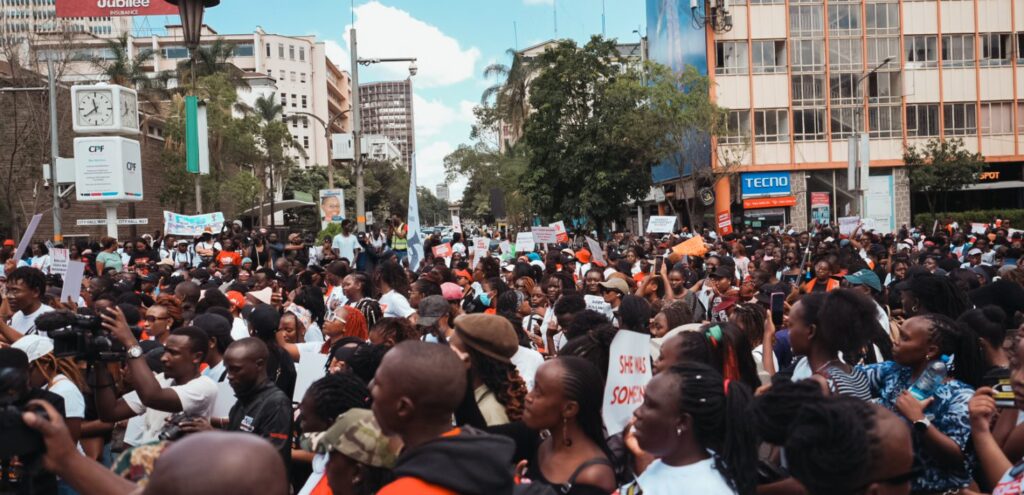- Business confidence slips to lowest since February
- Input prices rise mildly after back-to-back declines
- Steepest drops in activity and new work for seven months
Kenya’s business activity dips amid tax revolt
Kenya’s business activities fell sharply in June amid reports of widespread economic challenges and a negative impact on sales from protests and policy uncertainty, the Standard Bank’s Purchasing Managers’ Index (PMI) for June indicates. New business intakes dropped at the fastest rate since November last year, leading to a drop in business confidence and weaker job creation.
Although Kenyan firms also saw a renewed increase in their input costs in June, the rate of inflation was mild and had little impact on selling charges.
The survey by Stanbic Bank Kenya, compiled by S&P Global was conducted between June12 and June 26, with headline figure derived from the survey reading at 47.2 in June. Readings above 50.0 signal an improvement in business conditions on the previous month, while readings below 50.0 show a deterioration.
The headline PMI fell below the 50.0 neutral mark signaling a solid deterioration in the health of the Kenyan private sector economy. The decline was the sharpest recorded in seven months, which contrasted notably with the PMI’s 16-month high of 51.8 in May.
After registering a solid expansion midway through the quarter, private sector output dropped markedly in June, in line with a renewed and steep fall in new business intakes.
“In June, momentum in private sector activity declined, reflecting several concerns, top of the list being the proposed increase in taxes via the Finance Bill 2024, and the widespread protests in response, with unrest in Kenya restraining output and new business because customers delayed spending decisions in the face of such uncertainty,” Christopher Legilisho, Economist at Standard Bank, noted.
According to panel members, tough economic conditions brought on by the cost-of-living crisis, as well as protests surrounding the country’s finance bill hurt sales volumes. The downturn was partially softened by a rise in new orders across manufacturing, which was the only monitored sector to register growth in June.
The drop in sales tempered efforts to expand capacity at Kenyan companies in June. Purchasing activity decreased for the first time in three months, leading to a fresh reduction in firms’
inventories of inputs.
“After two months of increased purchasing activity by firms, there was a dip in purchasing quantities and inventories because of reduced sales in several sectors, namely construction, agriculture, wholesale and retail,” Legilisho explained.
He further noted that input prices, purchase prices and output prices recorded a mild increase in anticipation of the increased taxes proposed in the Finance Bill 2024. However, a stronger exchange rate and lower pump prices managed to restrain costs.
Read also: Kenya’s private sector activities rise as input costs continue to ease
Modest stock depletion
Altogether, the pace of stock depletion was only modest. Employment numbers continued to rise, but the increase was the weakest seen in the year-to-date.
Greater availability of raw materials and competition between vendors led to a further improvement in supplier performance during June. That said, the reduction in delivery times was the least marked since February.
Input prices in the Kenyan economy rose for the first time in three months in June, following a near-record decrease in the previous survey period. Higher taxation on products was commonly noted by respondents as driving up costs, offsetting further reports of reduced fuel prices and a positive impact on import prices from stronger exchange rates.
Notably though, the rate of input price inflation was modest and much softer than typically seen over the past four years. Cost increases were centered on the wholesale and retail, agriculture and services sectors, comparing with falls in manufacturing and construction.
With cost pressures relatively mild, Kenyan firms posted only a slight rise in their output prices in June. Business expectations towards future activity meanwhile slipped to a four-month low, as economic challenges led firms to show less optimism towards their sales and output forecasts.
“Despite the recent upheaval, it was notable that job creation improved for a sixth month running as firms increased capacity despite the dip in overall activity. However, business optimism for the year ahead remains fragile,” said Legilisho.
The Stanbic Bank Kenya PMI is compiled by S&P Global from responses to questionnaires sent to purchasing managers in a panel of around 400 private sector companies. The panel is stratified by detailed sector and company workforce size, based on contributions to GDP. The sectors covered by the survey include agriculture, mining, manufacturing, construction, wholesale, retail and services.
Survey responses are collected in the second half of each month and indicate the direction of change compared to the previous month. A diffusion index is calculated for each survey variable. The index is the sum of the percentage of ‘higher’ responses and half the percentage of ‘unchanged’ responses.
Read also: Kenya’s Political Instability Threat to Near-Term Economic Outlook, Experts Warn
Macroeconomic performance across Kenya industries

The growth was primarily buoyed by robust growths in agriculture, forestry and fishing activities (6.1 per cent), real estate (6.6 per cent), financial and insurance (7.0 per cent), information and communication (7.8 per cent) and accommodation and food services (28.0 per cent).
Similar to the first quarter of 2023, agricultural production was vibrant in the corresponding quarter of 2024, owing to favourable weather conditions that supported crop and animal production during the quarter.
Performance of transportation activities was comparably high relative to similar quarter of 2023, partly attributable to thriving agricultural activities.
In hospitality industry, accommodation and food service activities sustained the growth momentum that started in the 2022 recovery from the effects of Covid-19 pandemic.
“Similarly, growth of the financial and insurance activities accelerated from 5.9 per cent in the first quarter of 2023 to 7.0 per cent during the review quarter,” KNBS said in the quarter one performance report.
The country’s inflation eased to an average of 6.29 per cent in the first quarter of 2024 from 9.13 per cent in the corresponding quarter of 2023, mainly driven by lower prices of food and non-alcoholic beverages.
Looking ahead, the private sector expects sustained growth, the Central Bank of Kenya (CBK) has indicated.
The Agriculture Sector Survey by CBK conducted in May, shows that majority of respondents expect inflation to either remain unchanged or decrease in the next three months, on account of expected increase in food supply following favorable weather conditions, stability of the exchange rate, and easing fuel prices.
The CEOs Survey and Market Perceptions Survey which were conducted during the same period also revealed sustained optimism about business activity and economic growth prospects for the next 12 months.
“The optimism was attributed to expected continued good performance of agriculture, resilient services sectors, and a stable macroeconomic environment,” Central Bank of Kenya governor Kamau Thugge said.
Nonetheless, respondents expressed concerns about fiscal policy measures, high interest rates, and potential impact of geopolitical risks on the economy.
Read also: Kenya’s economy posts 5.6 per cent GDP growth in 2023











